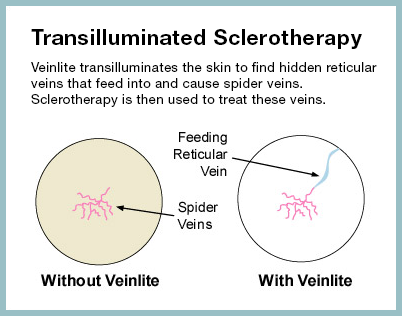Spider Veins
Although harmless, spider veins can cause you to be uncomfortable in your own skin. Luckily, with modern treatment options, spider veins can be dealt with simply and effectively. The following overview provides information on spider veins and their treatment.
What are spider veins?
Unsightly and embarrassing spider veins are the tiny relatives of varicose veins. Like varicose veins, spider veins are also caused by heredity, pregnancy, estrogen medications and prolonged sitting or standing. Unlike varicose veins, spider veins are typically not dangerous as they are simply enlarged venules (tiny veins). Together, varicose and spider veins affect more than half of people by the time they reach the age of 55.
Are there any spider veins that are more than a cosmetic concern?
If there is leg pain, heaviness or swelling, sometimes the superficial spider veins may be just the tip of the iceberg. There may be underlying varicose veins, which feed the small veins on the surface. We have an advanced imaging device to identify these hidden veins.
Furthermore, when located on the inside of the ankle, spider veins are not merely a cosmetic issue, but rather can be a sign of a more serious, internal derangement. A cluster of spider veins at the ankle is called corona phlebectasia and requires a special ultrasound study to identify the root cause before treatment will be effective. Typically, a leaking saphenous vein or incompetent perforating vein is the cause of ankle spider veins.
Do spider veins disappear if the underlying varicose veins are treated?
Spider veins have a distinct treatment of their own. Endovenous laser and ultrasound-guided sclerotherapy treat varicose veins and not spider veins. However, because varicose veins often "feed" the spider veins, the best time to treat spider veins is after eliminating these underlying, high-pressure varicose veins.
How then are spider veins treated? What new advances are available?
Spider veins can be challenging to treat, so it is critical to identify any underlying feeder veins prior to injecting them. We use an advanced imaging device to identify the root of the spider veins. After mapping out the underlying veins, the veins are carefully injected with an extremely fine and nearly painless needle. The treated veins are then absorbed through the body’s normal healing response. This technique is called transilluminated sclerotherapy. Because our practice specializes completely in vein therapy, we have the latest technology to identify these difficult-to-find veins.

Transilluminated sclerotherapy is our choice for treating problem spider veins. And despite all the advancements in laser technology, sclerotherapy still remains the overwhelming choice of vein specialists for spider vein treatment. Why? Because it is more effective, less expensive and less painful than any other treatment available, including laser vein treatment.
Learn more about transilluminated sclerotherapy
Facts about spider veins:
- In addition to being unsightly, spider veins can be difficult to treat.
- Spider veins should cause no more than a burning sensation. If leg aching, heaviness or swelling is present, an evaluation for internal varicosities should be undertaken.
- There are special devices that can be used to identify these underlying root veins.
- Some people experience poor results with laser treatment or injections because the underlying feeding veins were never treated.
- Spider veins at the ankle, also called corona phlebectasia, often indicate a more serious internal vein problem.
- Transilluminated sclerotherapy can provide thorough and effective treatment by treating both the spider veins and underlying feeding reticular veins.
Ready for better looking legs? Schedule your appointment today — 480-844-VEIN (8346).